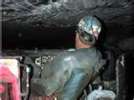
MSHA Issues Rock Dust Emergency Temporary Standard
Applying to about 415 underground bituminous coal mines in the United States, it says they must increase the incombustible content of dust to at least 80 percent in underground areas by Nov. 22.
MSHA issued an emergency temporary standard Thursday directing underground bituminous coal mines in the United States to increase the incombustible content of dust to at least 80 percent in underground areas. The standard says they also must raise the incombustible content of dust 0.4 percent for each 0.1 percent of methane present. Complying will cost the estimated 415 active underground bituminous mines $22 million annually; combined, they employ 47,119 miners and produced $17 billion worth of coal in 2009, according to data included in MSHA's Federal Register publication of the standard.
Comments (RIN: 1219-AB76, www.regulations.gov) are due by Oct. 19, and compliance is required by Oct. 7 for newly mined areas and by Nov. 22 for all other areas of these mines. MSHA will hold four public hearings on the standard: Oct. 26, St. Louis, Mo.; Oct. 28, Birmingham, Ala.; Nov. 16, Lexington, Ky.; and Nov. 18, Charleston, W.Va.
MSHA said it decided a revised standard for maintenance of incombustible content of rock dust (30 CFR 75.403) "is necessary to immediately protect miners from hazards of coal dust explosions." The agency based this determination on its accident investigation reports of mine explosions in intake air courses that involved coal dust, NIOSH recommendations for a new rock dusting standard, and MSHA's own experience and data.
An emergency temporary standard (ETS) must be replaced by a final standard within nine months. MSHA may issue an ETS for any type of grave danger, with or without any record of fatalities or serious injuries established by the agency. Previously, MSHA used an ETS to require:
- Hands-on training for miners in the use of self-contained self-rescue devices (June 1987)
- Training and mine evacuation procedures for underground coal mines (December 2002)
- New accident notification timeframes, new safety equipment, and training and drills in mine emergency evacuations (March 2006)
- Sealing of abandoned areas (May 2007)